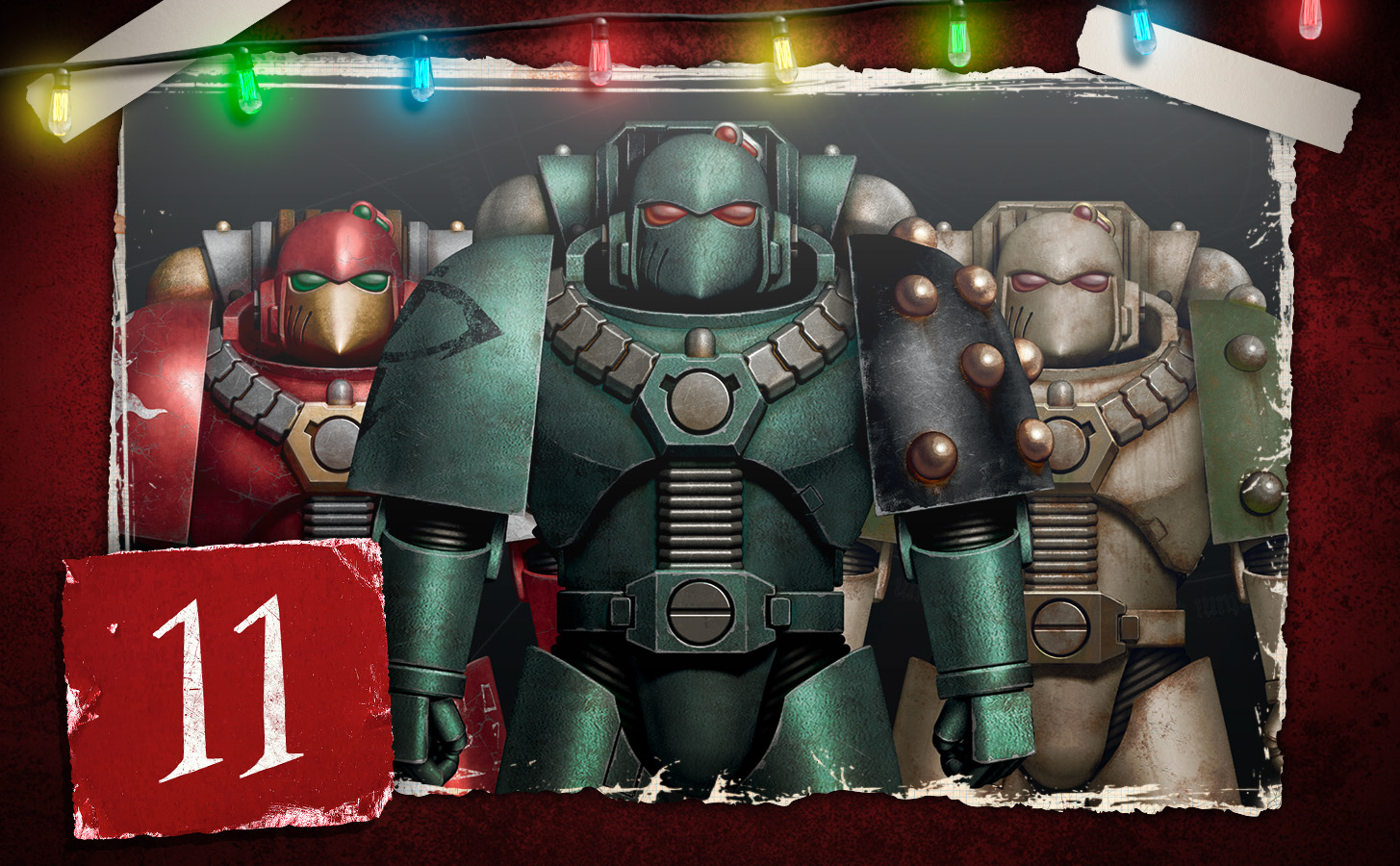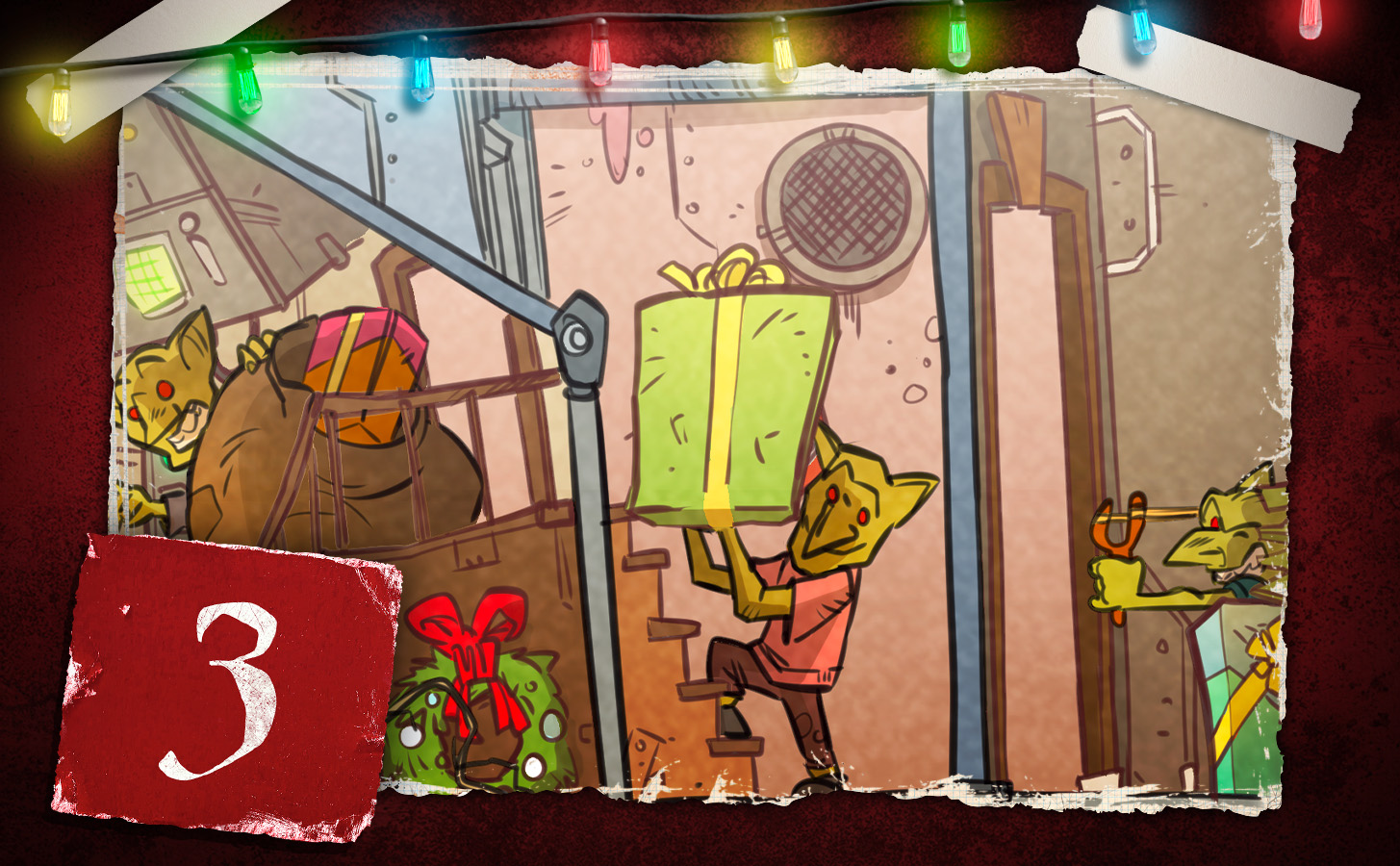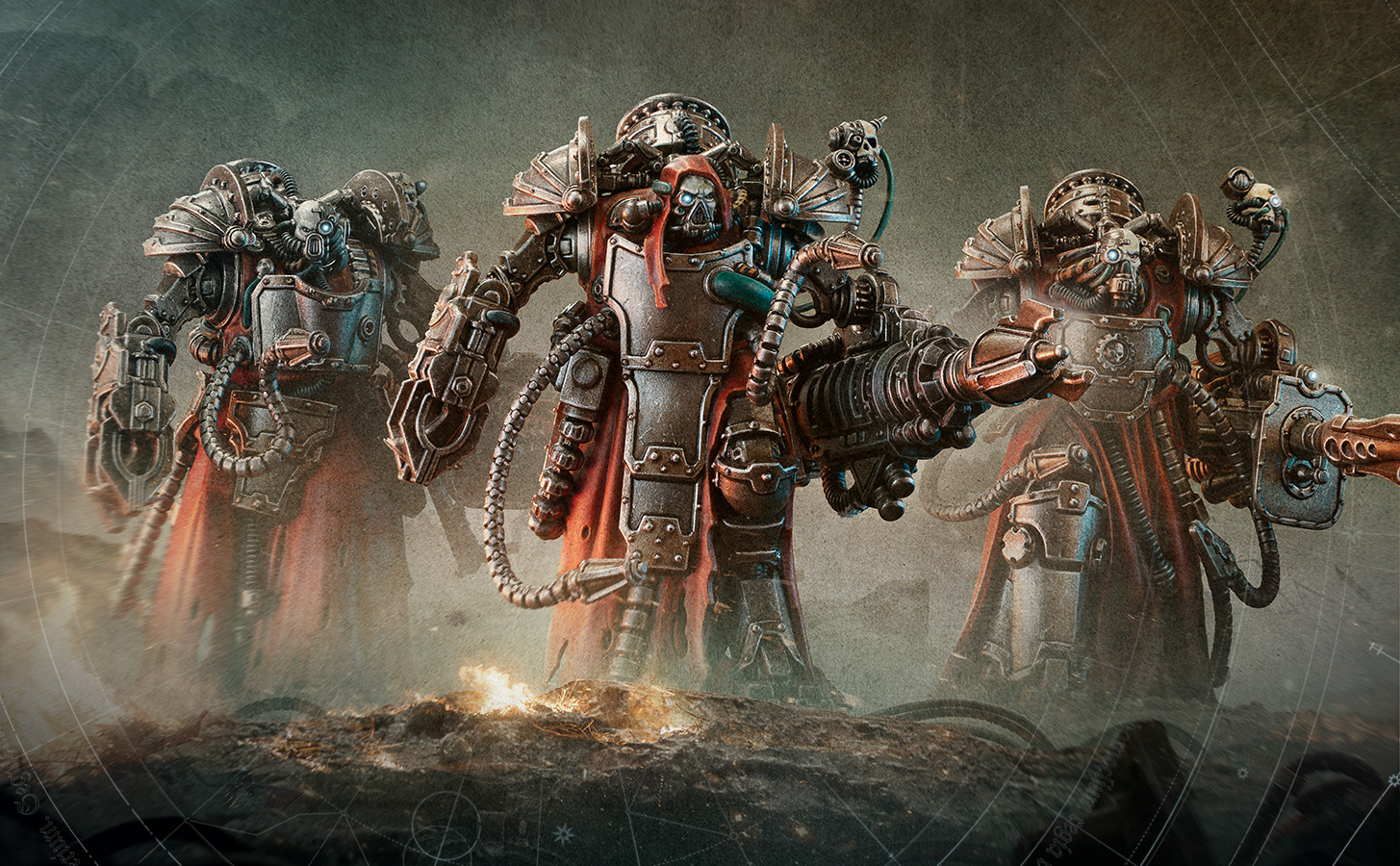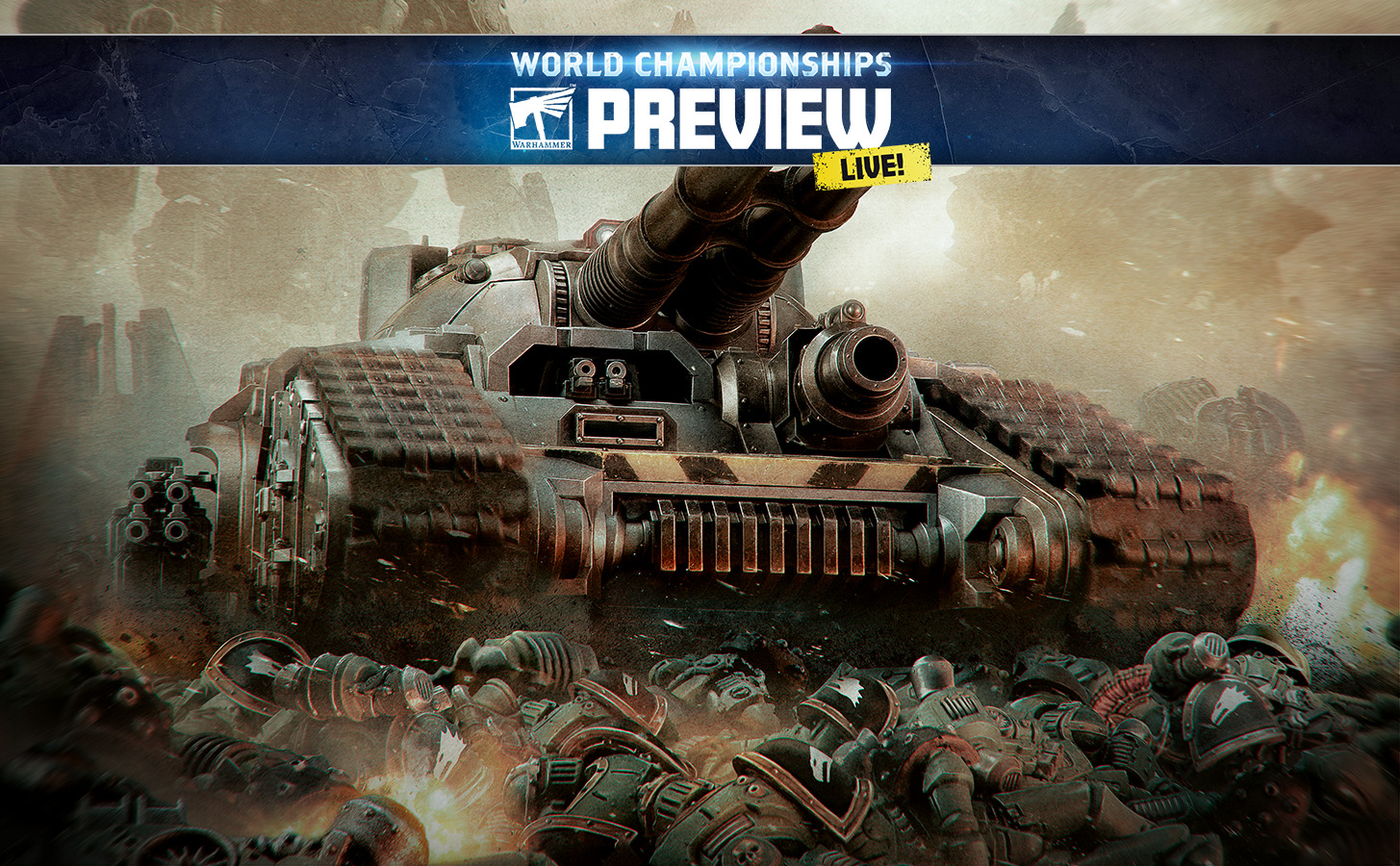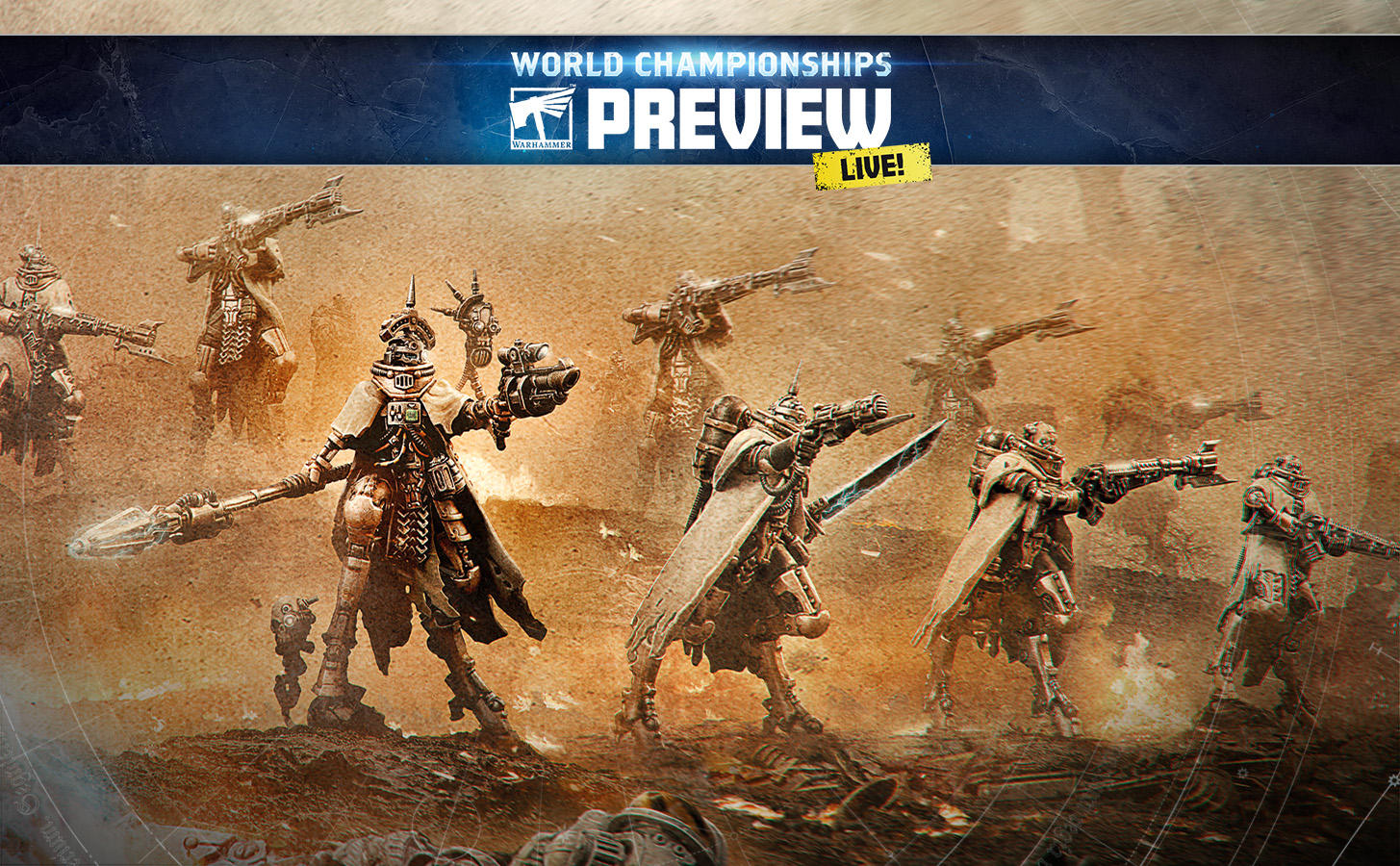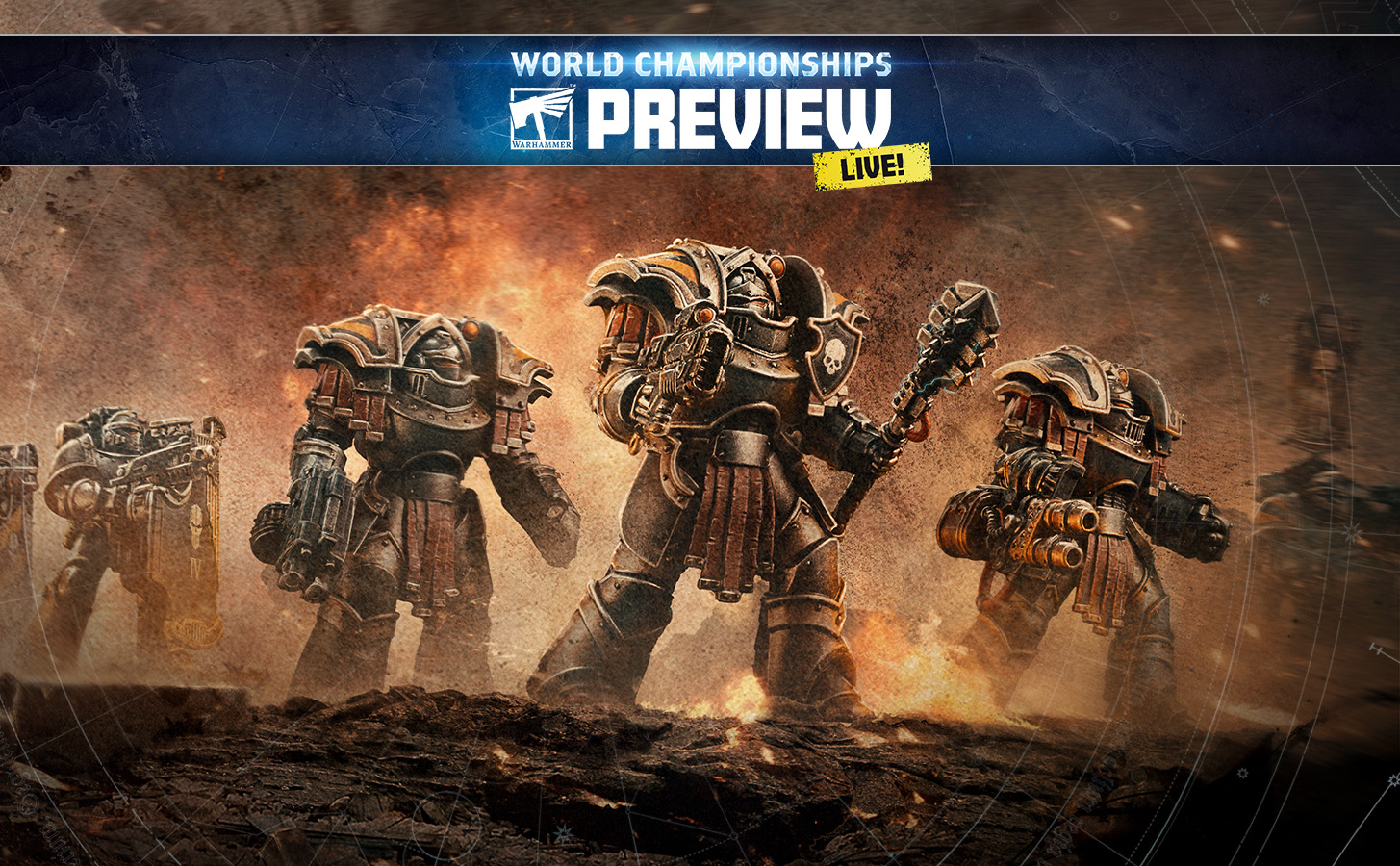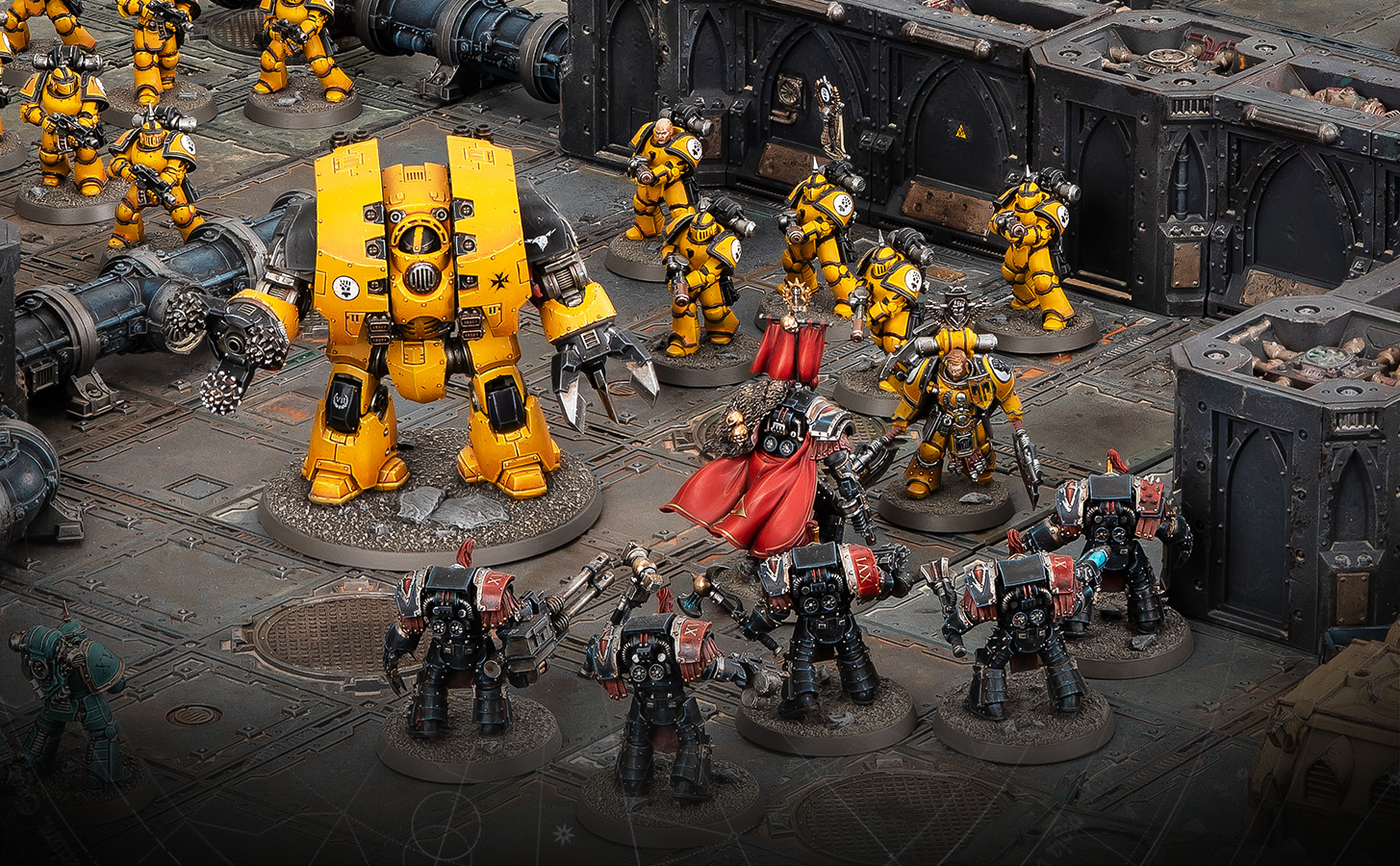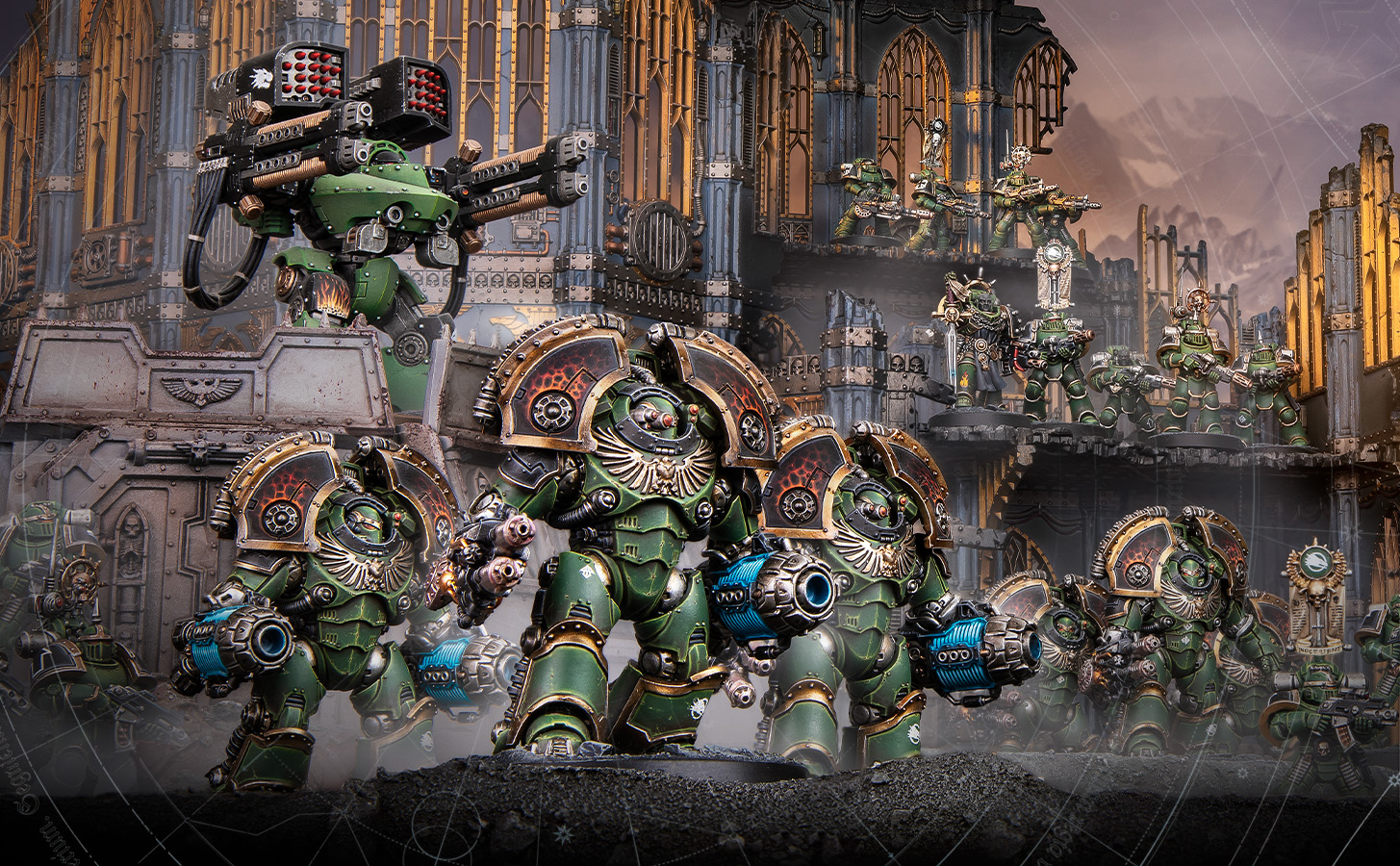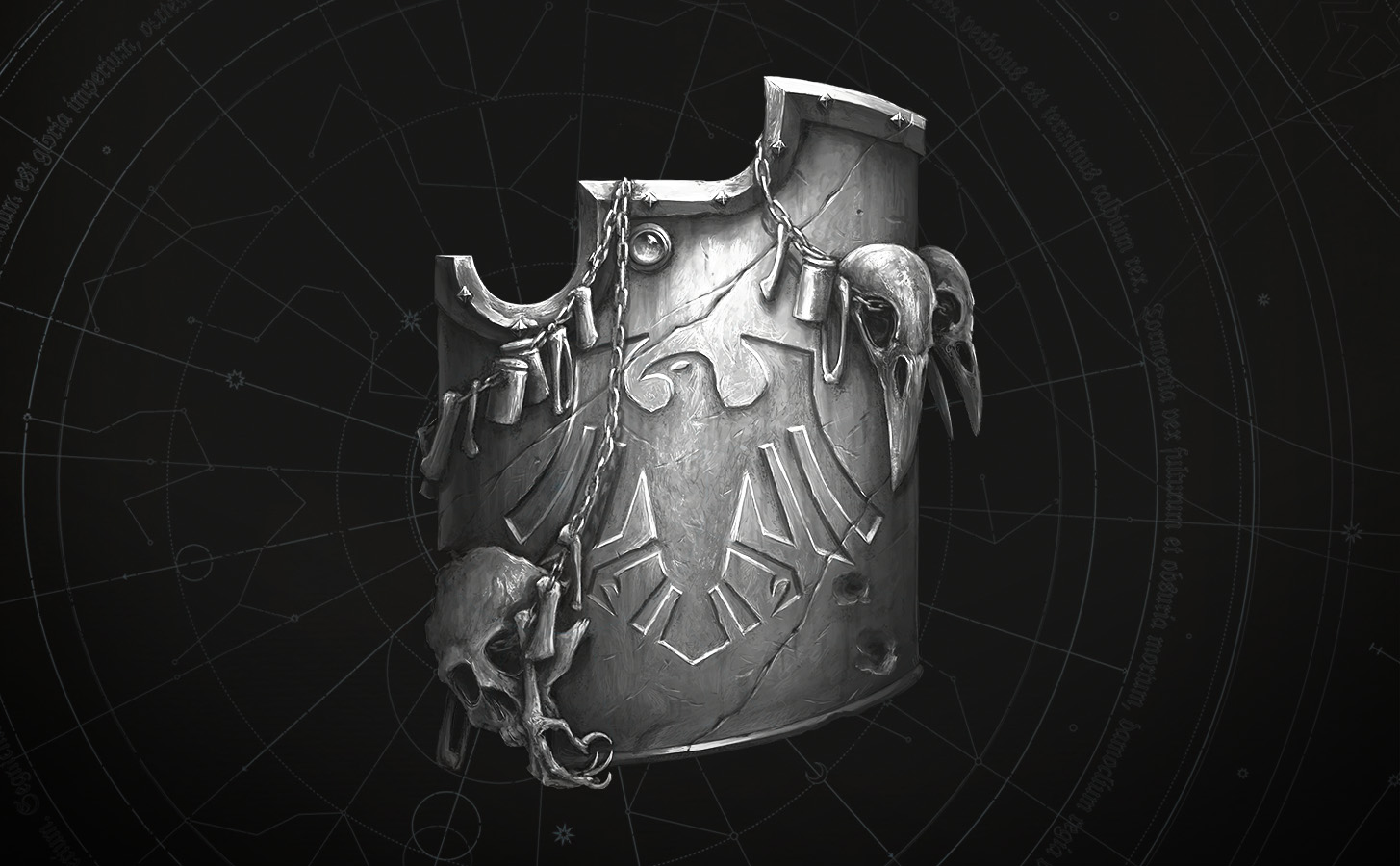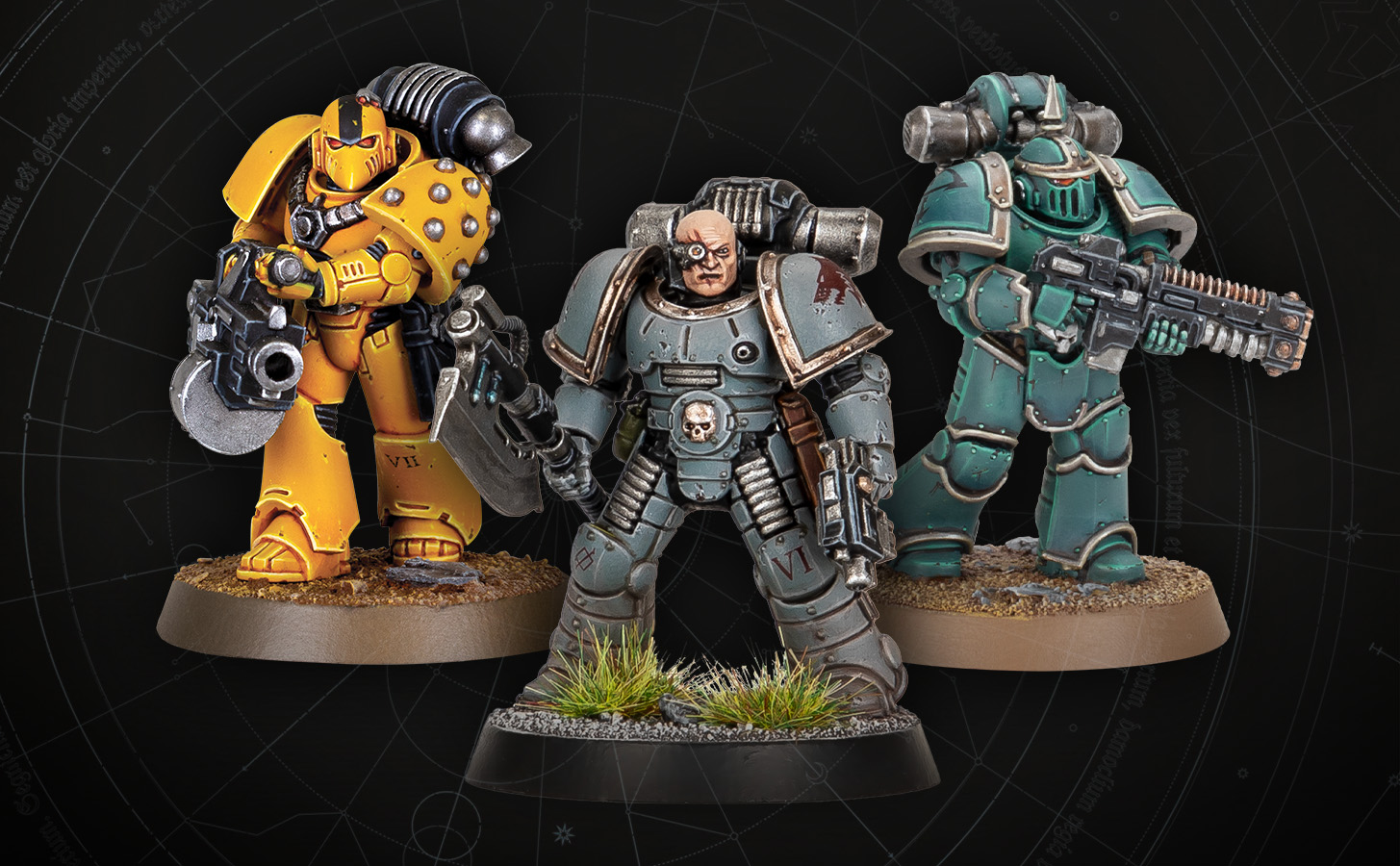Titans are among the mightiest terrestrial weapons in the Imperium’s arsenal – gargantuan walking weapon platforms with enough firepower to level cities. Generally only used when you wanted to destroy a world rather than conquer it, there were few threats to Mankind’s galactic ambition that truly warranted Titans until the Horus Heresy. Suddenly, god-engine fought god-engine in apocalyptic duels that dwarfed the battles beneath them, unleashing weapons of city-shattering proportions to desperately overwhelm their equally deadly foe – regardless of the collateral damage.
Accordingly, Titans can be a terrifying prospect in games of Warhammer: The Horus Heresy, especially if a player hadn’t expected to face one or prepared their army appropriately, but fear not noble Princeps – their rules in the Liber Questoris book come with a whole new mission type designed especially for them: Engine Kill Missions.

Felling a Titan
Before seeing what the new missions are like, though, we should dig deeper into Titan gameplay and what makes them extra special in the Age of Darkness. We touched briefly on the new rules back when we looked at how vehicles work in the new edition, and how a Titan has four separate armour locations that can be hit and damaged independently.

Warhound Titan
M | BS | Primary Armour | Exposed Armour | HP | Transport Capacity | |
Head | - | - | 14 | 12 | 8 | - |
Carapace | - | - | 14 | 12 | 10 | - |
Arms | - | 3 | 12 | 10 | 8 | - |
Legs | 20 | - | 14 | 12 | 10 | - |
Before attacks reach that armour, however, they have to break through the Void Shield Array. These defensive barriers can stand up to some of the most powerful weapons in the game, and until an attack scores a Glancing or Penetrating Hit against their Armour Value of 13, they’ll keep any incoming fire away.
Even then, void shields may regenerate at the end of the Princeps’ turn depending on how skilled their crew are. With up to eight shields protecting the Warlord Titans, even getting through to the armour underneath is a monumental task for most armies.
You may have noticed the profile above has a relatively low BS characteristic. This is for a Titan with the Minoris Crew Trait. Titans can now upgrade their Crew Trait by paying additional points when adding the model to your army, though Ultima crews can only be granted by Mission special rules or famous Titans.

Titan Void Shield Array (x)
A Model with this Special Rule gains an extra layer of
defence against Shooting Attacks.
A Model with this Special Rule has a number of void shields equal to the value of X. While a Model with this Special Rule still has void shields, each time that Model suffers a Hit from a Shooting Attack it must be allocated to the void shields.
Once all void shields have collapsed, any remaining Hits from Shooting Attacks must be allocated to the Titan Profile targeted by the attack.
A void shield has an Armour Value of 13, and any Glancing Hit or Penetrating Hit inflicted on it will cause that void shield to collapse. Regardless of the Damage value of a Hit it may not collapse more than one void shield, and once a Hit has collapsed a void shield or failed an Armour Penetration Test made against one it is discarded.
If, in the Effects Sub-Phase of the Controlling Player’s End Phase, a Titan has any collapsed void shields, the Controlling Player may roll a Dice for each collapsed void shield. Any Dice whose result is equal to or higher than the target number restores one void shield – with the target number decided by checking the [Crew] Trait of the Titan using the table below:
Minoris | 6 |
Senioris | 5+ |
Majoris | 4+ |
Ultima | 3+ |
Should attacks start to land, you first have to deplete the Hull Points for the location by scoring Glancing and Penetrating Hits. Once the Hull Points have been reduced to 0, that location is Crippled. Any further attacks on this location roll against the lower Exposed Armour Value, and if you inflict damage the Titan rolls against the Critical Damage table, adding the Damage of the attack to the result.

Titan Critical Damage Table
When rolling on this table, note that the following modifiers apply:
If the attack that caused this roll had a Strength of 8 or less, then it is counted as having a Damage Characteristic of 1, regardless of the Weapon’s actual Damage Characteristic, and gains no bonus to this roll from having the Armour-breaker (X) or Armourbane Special Rules.
If the attack that caused this roll had the Armour- breaker (X) or Armourbane Special Rule then add a bonus of +1 to the result of this roll.
If the attack that caused this roll had a Strength greater than 10 then roll two Dice instead of one, but discard the lowest rolled Dice before determining the result.
Dice | Result |
1-4 | Superficial Damage: No effect. |
5-6 | Structural Damage: No immediate effect, but add 1 to all future rolls on this table when attacking any Profile (this is cumulative and lasts for the rest of the Battle). |
7-19 | Secondary Explosions: Consult the specific results listed opposite based on the Profile that was hit. |
20+ | Reactor Failure: The Titan slumps and deactivates, it remains in place but takes no further damage and may not Move or Attack in any Phase. It is considered destroyed but can be salvaged and the Opposing Player scores Victory Points from the Engine Kill Objective. |
Secondary Explosions are a variety of serious effects that depend on the location. You might blow an arm clean off or cause the Titan to topple over and crush those beneath it. A clean hit to the Carapace can even detonate the reactor in spectacular fashion, evaporating anyone nearby and doing damage to everything on the battlefield!

Secondary Explosions
Carapace – Reactor Cascade: Every time this result is caused, the Titan’s Controlling Player must roll one Dice.
If the result of that Dice roll is a 1, 2, 3, 4 or 5 then the penalties of a Crippled Carapace are increased by 1.
If the result of the Dice roll is a 6, the Titan explodes, causing one Strength 6, AP , Damage 10 Hit to any Model within 6" of any part of the exploding Titan; a Strength 6, AP 3, Damage 4 Hit to any Model within 12" of any part of its Model and a Strength 4, AP ‘-’, Damage 1 Hit to all other Models on the Battlefield. The Titan is Removed as a Casualty and the Opposing Player scores half the normal Victory Points from the Engine Kill Objective.
Engine Kill
Engine Kill missions are designed to provide a fun and cinematic game whether one or both sides are bringing Titans to the table. These missions use the same Primary and Secondary Objectives as a regular game, but add additional ways for players to score by bringing down their opponent’s Titans and attacking special Strategic Objectives located beyond the bounds of the battlefield.

At the start of a Titan player’s first turn, they randomly determine which of three Strategic Objectives they have in their sights, representing long-range defensive emplacements, communications hubs, or the enemy Command Post. Instead of shooting their main Strategic Weapons* at something on the battlefield, they can instead target one of these Strategic Objectives and score Victory Points based on the damage they do.

Strategic Objective
Command Post
Armour: 14 Hull Points: 20
When the Command Post is reduced to Hull Points, the Titan Player scores 10 Victory Points, and the Opposing Player must make a Cool Check for each of their Units on the Battlefield that is not Engaged in Combat in the Effects Sub-Phase of that Player
Turn. If the Cool Check is failed, that Unit gains the Suppressed Tactical Status.
From the second turn onwards, the active player can randomly determine a new Strategic Objective to target, so they always have something to work towards during the mission.
In the first of the two Engine Kill missions, War of Gods, both players can deploy Titans and work towards their own Strategic Objectives, but the second – Giant Killer – is a pure David-and-Goliath scenario where the attacker must throw their regular army against the defender’s Titan and bring it down while capturing Primary Objectives around its feet. Meanwhile, the defender must eradicate as many Strategic Objectives as possible, carefully choosing when to rack up Victory Points and when to destroy the most pressing threats.

These missions make a battle between Titans a memorable event that fits alongside your regular games of Warhammer: The Horus Heresy, while remaining fun for those who have to brave an encounter with these behemoths with mere mortals on their side.
There’s still more we’d love to cover – such as Swarm Assaults with infantry climbing all over the Titan and using the Titan War Horn to blow out the enemy’s eardrums – but you’ll just have to see the rest for yourself when Liber Questoris releases alongside the awesome Saturnine boxed set in just a few weeks.
* Usually the big ones on their arms.





